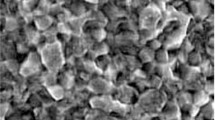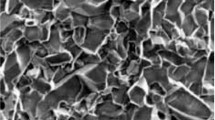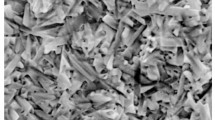Results are given for a study of the effect of surface grinding regimes with diamond wheels on the surface condition of reaction-sintered ceramic based on silicon carbide (SiSiC-ceramic). The effect on machined surface is revealed for grinding depth, longitudinal and transverse feed on roughness, waviness, and morphology. It is established that a SiSiC-ceramic surface after grinding has an original morphological picture.







Similar content being viewed by others
Change history
24 October 2017
A correction to this article has been published.
References
G. G. Gnesin, Silicon Carbide Materials [in Russian], Metallurgiya, Moscow (1977(.
V. V. Luchinin, P. P. Mal’tsev, and E. P. Malyakov, “Silicon carbide— a strategic material of future electronics,” Élektronika: Nauka, Teknologiya, Biznes, No. 3/4, 61 – 64 (1997).
A. P. Garshin, V. V. Karlin, G. S. Oleinik, et al., Structural Silicon Carbide materials [in Russian], Mashinostroenie, Leningrad (1975).
O. V. Dushko, A. P. Umanskii, and D. O. Pushkarev, “Composite wear-resistant material based on silicon carbide,” Ogneupor. Tekhn. Keram., 22 – 24 (2005).
A. P. Podoba, G. S. Golubyak, and V. G. Kulich, et al., “Microstructure and some physicomechanical properties of silicon carbide ceramic,” Sverkhtverd. Materialy, No. 6, 18 – 20 (1986).
A. Andrews, M. Herrmann, M. Sephton, et al., “Electrochemical corrosion of solid and liquid phase sintered silicon carbide in acidic and alkaline environments,” J. Europ. Ceram. Soc., 27, 2127 – 2135 (2007).
A. P. Garshin and Yu. N. Vil’k, “ Effect of some production parameters of material structure formation based on reaction-sintered silicon carbide,” Ogneupor. Tekhn. Keram., No. 8, 2 – 8 (1996).
G. G. Gnesin, I. V. Gridneva, Yu. P. Dyban’, et al., Effect of structure in mechanical properties of reaction-sintered silicon carbide materials,” Poroshk. Metall., No. 9, 61 – 67 (1987).
V. P. Paranosenkov, A. A. Chikina, and M. A. Andreev, “Structural materials based on self-bonded silicon carbide,” Ogneupor. Tekhn. Keram., No. 7, 37 – 40 (2006).
I. Yu. Kelina, V. V. Lenskii, N. A. Golubeva, et al., “Impact-resistant ceramic based on silicon carbide,” Ogneupor. Tekhn. Keram.,, No. 1/2, 17 – 24 (2010).
V. V. Kuzin, “Effective use of high density ceramic for manufacture of cutting and working tools,” Refract. Indust. Ceram., 51(6), 421 – 426 (2010).
M. K. Aghajanian, B. N. Morgan, and J. R. Singh, “A new family of reaction bonded ceramics for armor applications,” Ceram. Trans., 134, 527 – 539 (2002).
V. V. Kuzin, S. I. Dos’ko, V. F. Popov, S. Yu. Fedorov, and M. Yu. Fedorov, “Tooling for high-speed cutting,” Russ. Engineering Research, 25(9), 20 – 25 (2005).
A. A. Lebedev, A.M. Ivanov, and M. B. Strokan, “Radiation-resistant SiC and hard radiation detectors based upon it,” Fiz. Tekhn. Poluprovod., 38(2), 129 – 150 (2004).
S. Cvetkoviæ, C. Morsbach, and L. Rissing, “Ultra-precision dicing and wire sawing of silicon carbide (SiC),” Microelectron. Eng., 88, 2500 – 2504 (2011).
O. V. Dushko and D. O. Pushkarev, “Wear-resistant ceramic end seals for the petrochemical industry,” in: Abrasive Treatment, Abrasive Tools and Materials: Coll. Internat. Sci.-Tech Conf., VIStekh (branch) VolgGASU, Volzhskii (2004).
Sanjay Agarwal, “Optimizing machining parameters to combine high productivity with high surface integrity in grinding silicon carbide ceramics,” Ceram. Internat., 42, 6244 – 6262 (2016).
Jianguo Cao, Yongbo Wu, Dong Lu, et al., “Material removal behavior in ultrasonic-assisted scratching of SiC ceramics with a single diamond tool,” Internat. J. Machine Tools and Manufacture, 79, 49 – 61 (2014).
Quanli Zhang, Suet To, Qingliang Zhao, et al., “Amorphization and segregation based surface generation of reaction-bonded Si/SiC composites under micro grinding,” Internat. J. Machine Tools and Manufacture, 95, 78 – 81 (2015).
O. V. Dusko and V. M. Shumyacher, Diamond Grinding of Silicon Carbide ceramics for Engineering [in Russian], Volg-GASU, Volgograd (2009).
V. V. Kuzin, S. Yu. Fedorov, “Roughness of High Hardness Ceramic Correlation of Diamond Grinding Regimes with Al2O3-Ceramic Surface Condition,” Refract. Indust. Ceram., 57, 388 – 393 (2016).
V. V. Kuzin and S. Yu. Federov, “Correlation of diamond grinding regimes with surface condition of ceramic based on zirconium dioxide,” Novye Ogneupory, No. 9, 63 – 68 (2016).
V. V. Kuzin and S. Yu. Federov, “Correlation of diamond grinding regimes with surface condition of ceramic based on zirconium dioxide,” Novye Ogneupory, No. 11, 60 – 65 (2016).
V. V. Kuzin, S. Yu. Federov, and S. N. Grigor’ev, “Correlation of diamond grinding regime with Si3N4-ceramic surface condition,” Novye Ogneupory, No. 1, 67 – 70 (2017).
V. V. Kuzin, “Technological aspects of diamond grinding of the nitride ceramics,” Russ. Engineering Research, 24(1), 23 – 28 (2004).
V. Kuzin, “A model of forming the surface layer of ceramic parts based on silicon nitride in the grinding process,” Key Engineering Materials. Precision Machining, 496, 127 – 131 (2012).
The work was carried out with financial support of the RF Ministry of Education and Science within the scope of performing a state assignment in the sphere of scientific activity.
Author information
Authors and Affiliations
Corresponding author
Additional information
Translated from Novye Ogneupory, No. 3, pp. 179 – 185, March, 2017.
A correction to this article is available online at https://doi.org/10.1007/s11148-017-0108-x.
Rights and permissions
About this article
Cite this article
Kuzin, V.V., Fedorov, S.Y. & Grigor’eva, S.N. Correlation of Diamond Grinding Regimes with SiSiC-Ceramic Surface Condition. Refract Ind Ceram 58, 214–219 (2017). https://doi.org/10.1007/s11148-017-0083-2
Received:
Published:
Issue Date:
DOI: https://doi.org/10.1007/s11148-017-0083-2




